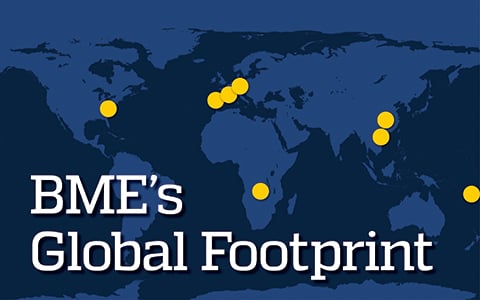Bioengineering across borders

As Johns Hopkins University looks to continue expanding its global footprint, Biomedical Engineering is right on target. The department has built strategic partnerships with leading BME programs and clinicians in locations such as Spain, China, France, and Singapore.
Take the Center for Bioengineering Innovation and Design, which sets the standard nationwide for its design collaboration opportunities and teaching methodology. Each year, master’s degree candidates spend two months in clinical rotations before heading on monthlong trips to Europe, Southeast Asia, and sub-Saharan Africa to assess clinical needs. Teams of undergraduate and graduate students then spend the academic year working together to design innovative solutions to pressing global health needs.
The program is just one example of BME’s growing reach in translational medicine, research, and education. Nicholas Durr, CBID’s director of undergraduate programs, for example, is one of four co-founders of PlenOptika, a company working to develop ophthalmic technologies — like a hand-held device to prescribe corrective eyeglasses — for low-resource countries.
“Biomedical engineering is intrinsically international,” says Jeff Siewerdsen, a professor of biomedical engineering, computer science, and radiology. “There’s a lot of good work going on internationally, especially in imaging and image-guided procedures. It’s a big area, and there’s a lot of talent from Europe.”
Siewerdsen estimates that about three-quarters of his laboratory staff hail from other countries, not only in Europe but also from China and other parts of globe, largely because of their strong math and computing skills. In recent years, he has hosted BME PhD students from Spain for research rotations.
As part of the European Union’s TAHITI Project, which allows several EU researchers to visit JHU, Eugenio Marinetto from Charles III University of Madrid came to Johns Hopkins in fall 2014 to work on ultrasound-guided surgery projects and returned in 2015 to study high-resolution cone-beam computed tomography of the bones for osteoarthritis. Alejandro Sisniega, also from the Spanish university, spent six months in the lab in 2012 pursuing projects in cone-beam CT and 3-D image reconstruction and is now back for his third year of postdoctorate work. Sisniega says his work in Spain was more preclinical, studying imaging in mice and rats, so he appreciates the opportunity to work with clinical applications in a larger hospital. Siewerdsen’s lab also has a research agreement with Siemens Healthcare in Germany.
Additional educational exchanges are happening with institutions in China, says Biomedical Engineering Professor Xingde Li. This summer will mark the third year of Johns Hopkins University and Shanghai Jiao Tong University sending five to six undergraduate students to each other’s campuses for short-term research projects. Li and other researchers are also in discussions with the Chinese Academy of Sciences’ Suzhou Institute of Biomedical Engineering and Technology to develop a joint research center.
At the Institute for Computational Medicine, Natalia Trayanova, Patrick Boyle and BME graduate student Sohail Zahid have been collaborating with cardiac researchers at the University of Bordeaux in France to improve diagnostics for patients with atrial fibrillation, an irregular, often rapid heart rhythm that can lead to stroke.
Using MRI images of patients’ hearts, they construct three-dimensional computer models depicting each heart’s unique anatomy and scar tissue patterns. The idea is to try to determine the exact regions of the heart responsible for the abnormal rhythms so doctors will know where to perform catheter ablation (the use of radiofrequency energy to destroy a small area of problematic heart tissue) and be able to perform simulations prior to surgery.
“We seek ablation targets that provide the most efficient fix, stopping the arrhythmia with the fewest and smallest burns,” says Trayanova, the Murray B. Sachs Professor of biomedical engineering. “We believe this could significantly shorten ablation procedures, decrease complications, and increase success rates.”
Nitish Thakor, a professor of biomedical engineering, electrical engineering, and neurology, has been sharing his expertise with institutions in Asia. He now leads the Singapore Institute for Neurotechnology, which comprises a growing group of scientists, clinicians, engineers, and students studying areas like neuromorphic engineering — a field that combines biology, physics, mathematics, computer science, and engineering to design artificial neural systems. Thakor also is a visiting professor with Shanghai Jiao Tong University’s Med-X Research Institute and with the Indian Institute of Technology Gandhinagar. And he is chairing two international conferences this year: the IEEE’s sixth annual biomedical robotics and biomechatronics conference in Singapore in June and the Gordon Research Conference on Advanced Health Informatics in Hong Kong in July.
— Karen Blum
